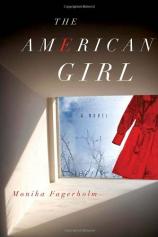Reading Group Guide
Discussion Questions
The American Girl

1. The structure of The American Girl is not a conventional linear narrative. The author forces the reader to assemble a coherent story from impressions, occasional historical facts, the characters’ play-acting, mysterious clues, interior monologues, and the rhythm of her prose. This technique, which mirrors real life, can be frustrating or liberating. Which did you find it? Discuss the ways this technique hinders understanding the characters’ actions, and the ways it deepens our understanding their inner lives.
2. Eddie de Wire --- the American Girl --- is a Swedish-speaking Finn who falls for the early culture of punk rock while traveling around the United States in the late 1960s. The author makes many references to the music of that era, liberally sprinkled throughout the text, showing that popular music is terribly important for adolescents as they establish their identities. Discuss the ways in which the musical references such as “What Have They Done to My Song, Ma” help develop Eddie’s character in the novel.
3. On page two of the novel, we are told that Eddie de Wire was drowned in a marsh. When do we find out how she died and whether she was murdered or not? Were you surprised to learn what really happened or had the author given you enough clues such that the revelation grew organically from all that had come before? When did you suspect the truth?
4. Much of the action in the novel is seen through the eyes of Sandra and Doris, the two teenage girls who construct their own fantasy narrative based on the mystery of Eddie de Wire’s death and the supposed involvement of all the inhabitants of their seaside community, even as they explore the sexual limits of their summer friendship. Is their view of Eddie’s life and death true? What about their view of their parents and their parents’ adult friends --- even if the facts are false, is the impression “true”? Can you cite other instances in which the stories people make up are truer than straight reportage?
5. In the novel we detect a constant tension between the year-round inhabitants of the District (who are lower working class) versus the nouveau riche summer people. How does the author use Doris Flinkenberg’s attempt to move between these two worlds to shed light on the struggle between classes?
6. Women’s liberation was just beginning to become an issue during the period the main action of the novel takes place. Free of being typecast as second-class citizens, women were then challenged to establish their own identities, and independence. The book is filled with many female characters, from teenage girls to the Islander’s sex kittens, from wives and aunts to professional women and academics, from rich girls to impoverished and grieving mothers, seemingly illustrating the whole spectrum of the gender’s possible lives. Name five major female characters and describe how each one displays a separate aspect of modern womanhood.
7. Some of the characters have more than one name; for example, Bengt is also called Bencku. Some of the characters have the same name: both Sandra and Doris are called The Marsh Queen. And some of the characters are only known by their nickname, like The Black Sheep. The author uses this technique to simulate the way we come by knowledge in real life, having to tease out “who did what to whom” when different witnesses use different names to refer to the same people. Make a list of all the names that Doris and Sandra use in referring to themselves and others. How many names are you known by?
8. Can you identify “the City by the Sea”? A clue: the novel alludes to an international summit meeting that took place there in the mid-1970s.What do you know about the culture of Finland and the various communities that comprise its population?
9. John Gardner once commented that there are only two basic plot-lines out of which all narratives are woven: someone goes on a journey, or a stranger comes to town. In The American Girl, who goes on a journey? And who is a stranger that comes to town (other than Eddie de Wire)?
The American Girl
- Publication Date: February 16, 2010
- Genres: Fiction
- Paperback: 528 pages
- Publisher: Other Press
- ISBN-10: 1590513045
- ISBN-13: 9781590513040







